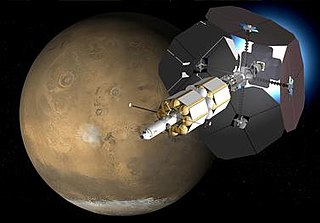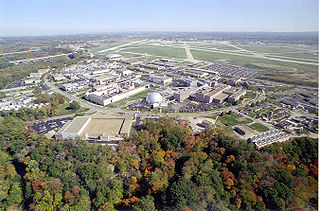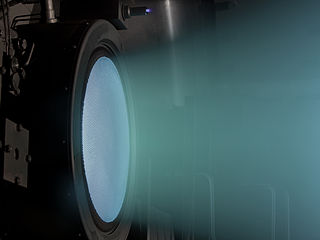Related Research Articles

Deep Space 1 (DS1) was a NASA technology demonstration spacecraft which flew by an asteroid and a comet. It was part of the New Millennium Program, dedicated to testing advanced technologies.

Spacecraft propulsion is any method used to accelerate spacecraft and artificial satellites. In-space propulsion exclusively deals with propulsion systems used in the vacuum of space and should not be confused with space launch or atmospheric entry.

In spacecraft propulsion, a Hall-effect thruster (HET) is a type of ion thruster in which the propellant is accelerated by an electric field. Hall-effect thrusters are sometimes referred to as Hall thrusters or Hall-current thrusters. Hall-effect thrusters use a magnetic field to limit the electrons' axial motion and then use them to ionize propellant, efficiently accelerate the ions to produce thrust, and neutralize the ions in the plume. The Hall-effect thruster is classed as a moderate specific impulse space propulsion technology and has benefited from considerable theoretical and experimental research since the 1960s.

An ion thruster, ion drive, or ion engine is a form of electric propulsion used for spacecraft propulsion. An ion thruster creates a cloud of positive ions from a neutral gas by ionizing it to extract some electrons from its atoms. The ions are then accelerated using electricity to create thrust. Ion thrusters are categorized as either electrostatic or electromagnetic.

A fusion rocket is a theoretical design for a rocket driven by fusion propulsion that could provide efficient and sustained acceleration in space without the need to carry a large fuel supply. The design requires fusion power technology beyond current capabilities, and much larger and more complex rockets.

The Variable Specific Impulse Magnetoplasma Rocket (VASIMR) is an electrothermal thruster under development for possible use in spacecraft propulsion. It uses radio waves to ionize and heat an inert propellant, forming a plasma, then a magnetic field to confine and accelerate the expanding plasma, generating thrust. It is a plasma propulsion engine, one of several types of spacecraft electric propulsion systems.

NASA John H. Glenn Research Center at Lewis Field is a NASA center within the cities of Brook Park and Cleveland between Cleveland Hopkins International Airport and the Rocky River Reservation of Cleveland Metroparks, with a subsidiary facility in Sandusky, Ohio. Its director is James A. Kenyon. Glenn Research Center is one of ten major NASA facilities, whose primary mission is to develop science and technology for use in aeronautics and space. As of May 2012, it employed about 1,650 civil servants and 1,850 support contractors on or near its site.

Dawn is a retired space probe that was launched by NASA in September 2007 with the mission of studying two of the three known protoplanets of the asteroid belt: Vesta and Ceres. In the fulfillment of that mission—the ninth in NASA's Discovery Program—Dawn entered orbit around Vesta on July 16, 2011, and completed a 14-month survey mission before leaving for Ceres in late 2012. It entered orbit around Ceres on March 6, 2015. In 2017, NASA announced that the planned nine-year mission would be extended until the probe's hydrazine fuel supply was depleted. On November 1, 2018, NASA announced that Dawn had depleted its hydrazine, and the mission was ended. The derelict probe remains in a stable orbit around Ceres.

Solar electric propulsion (SEP) refers to the combination of solar cells and electric thrusters to propel a spacecraft through outer space. This technology has been exploited in a variety of spacecraft designs by the European Space Agency (ESA), the JAXA, Indian Space Research Organisation (ISRO) and NASA. SEP has a significantly higher specific impulse than chemical rocket propulsion, thus requiring less propellant mass to be launched with a spacecraft. The technology has been evaluated for missions to Mars.

The gridded ion thruster is a common design for ion thrusters, a highly efficient low-thrust spacecraft propulsion method running on electrical power by using high-voltage grid electrodes to accelerate ions with electrostatic forces.

An ion beam is a beam of ions, a type of charged particle beam. Ion beams have many uses in electronics manufacturing and other industries. There are many ion beam sources, some derived from the mercury vapor thrusters developed by NASA in the 1960s. The most widely used ion beams are of singly-charged ions.

High Power Electric Propulsion (HiPEP) is a variation of ion thruster for use in nuclear electric propulsion applications. It was ground-tested in 2003 by NASA and was intended for use on the Jupiter Icy Moons Orbiter, which was canceled in 2005.

A plasma propulsion engine is a type of electric propulsion that generates thrust from a quasi-neutral plasma. This is in contrast with ion thruster engines, which generate thrust through extracting an ion current from the plasma source, which is then accelerated to high velocities using grids/anodes. These exist in many forms. However, in the scientific literature, the term "plasma thruster" sometimes encompasses thrusters usually designated as "ion engines".

A colloid thruster is a type of low thrust electric propulsion rocket engine that uses electrostatic acceleration of charged liquid droplets for propulsion. In a colloid thruster, charged liquid droplets are produced by an electrospray process and then accelerated by a static electric field. The liquid used for this application tends to be a low-volatility ionic liquid.

Spacecraft electric propulsion is a type of spacecraft propulsion technique that uses electrostatic or electromagnetic fields to accelerate mass to high speed and thus generating thrust to modify the velocity of a spacecraft in orbit. The propulsion system is controlled by power electronics.

SERT-1 was a NASA probe used to test electrostatic ion thruster design and was built by NASA's Lewis Research Center. SERT-1 was the first spacecraft to utilize ion engine design. It was launched on July 20, 1964 on a Scout rocket. It carried two electric propulsion engines; of the two, the first, an electron-bombardment ion engine was run for a total of 31 minutes and 16 seconds. This was the first time that an ion engine of any type had been operated in space, and demonstrated that the neutralizer worked as predicted.

The NASA Evolutionary Xenon Thruster (NEXT) project at Glenn Research Center is a gridded electrostatic ion thruster about three times as powerful as the NSTAR used on Dawn and Deep Space 1 spacecraft. It was used in DART, launched in 2021.

The Asteroid Redirect Mission (ARM), also known as the Asteroid Retrieval and Utilization (ARU) mission and the Asteroid Initiative, was a space mission proposed by NASA in 2013; the mission was later cancelled. The Asteroid Retrieval Robotic Mission (ARRM) spacecraft would rendezvous with a large near-Earth asteroid and use robotic arms with anchoring grippers to retrieve a 4-meter boulder from the asteroid.
NASA's Pathfinder Technology Demonstrator (PTD) Project is a series of tech demonstrations of technologies aboard a series of nanosatellites known as CubeSats, providing significant enhancements to the performance of these versatile spacecraft. Each of the five planned PTD missions consist of a 6-unit (6U) CubeSat with expandable solar arrays.

SPT-140 is a solar-powered Hall-effect ion thruster, part of the SPT-family of thrusters. SPT stands for Stationary Plasma Thruster. Like other members of the SPT series, it creates a stream of electrically charged xenon ions accelerated by an electric field and confined by a magnetic field.
References
- ↑ "In memory: Harold R. Kaufman". Colorado State University. 9 January 2018. Retrieved 20 July 2019.
- 1 2 "Albert Nerkin Award Winners". Archived from the original on 2017-01-21. Retrieved 2017-02-24.
- 1 2 3 "Dr. Harold R. Kaufman". NASA. September 6, 2016. Retrieved January 27, 2023.
- ↑ "Chapter 6: NACA Research on Hydrogen for High-Altitude Aircraft". Liquid Hydrogen as a Propulsion Fuel 1945-1959, Notes citations #24, #25. NASA. Retrieved January 27, 2023.
- ↑ "Harold Kaufman". Archived from the original on 2010-03-23. Retrieved 2009-10-06.
- ↑ NASA Glenn, "SPACE ELECTRIC ROCKET TEST II (SERT II) Archived 2011-09-27 at the Wayback Machine (Accessed July 1, 2010)
- ↑ US 4862032A,Kaufman, Harold R.&Robinson, Raymond S.,"End-Hall ion source",published Aug 29, 1989
- ↑ "Past Professional Awards". AVS. Archived from the original on January 21, 2017. Retrieved February 24, 2017.
- ↑ "NASA Glenn Inducts Nine Exemplary Employees into Hall of Fame". NASA official site. September 9, 2016. Retrieved February 24, 2017.
- ↑ "Harold R. Kaufman, Chair and Professor Emeritus, Physics". CNS Emeritus/Emerita Directory. Colorado State University College of Natural Sciences. 4 June 2013. Archived from the original on 2010-06-10.